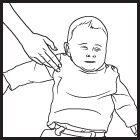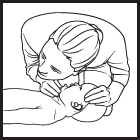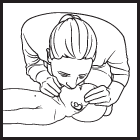- Normal labor can begin 3 weeks prior to the anticipated due date up until 2 weeks afterward.
- There is no way to precisely predict when labor will begin.
- In the first stage of labor, the cervix dilates and effaces (thins out). Once contractions begin, they usually increase in strength, duration, and frequency.
- The second stage of labor begins when the cervix is completely (10 centimeters) dilated. It ends when, following expulsive efforts (pushing) by the mother, the infant is delivered.
- During the third stage of labor, the placenta and membranes are delivered.
- There are a number of methods for monitoring the fetus that may be used during labor.
- Options for pain control during labor include breathing exercises, imagery, relaxation techniques, medications, and regional anesthesia.
- light, rhythmic, circular stroking of your abdomen (effleurage)
- gentle muscle massage of your shoulders, back, legs, or feet
- deep, steady pressure or circular massage with fists or heels of the hands-on your lower back—this helps if you have back labor
- firm, long strokes down your arms or thighs in time with your breathing
- temple and head massage
- Make your space comfortable—warm, peaceful, and safe with no distractions.
- Start at one end of your body—either your head or feet. Tense your muscles for 5 seconds at a time and then relax them for at least 10–15 seconds. When you tense your muscles, breathe in. Work your way through all the muscle groups of your body.
- When you relax your muscles, breathe out. As you breathe out, imagine all the tension flowing out of your body with your breath.
- Think about the muscles that you’ve relaxed. Let them become soft, loose, and warm.
 | 1. Shout and Tap Shout and gently tap the child on the shoulder. If there is no response and not breathing or not breathing normally, position the infant on his or her back and begin CPR. |
 | 2. Give 30 Compressions Give 30 gentle chest compressions at the rate of 100-120/minute. Use two or three fingers in the center of the chest just below the nipples. Press down approximately one-third the depth of the chest (about 1 and a half inches). |
 | 3. Open The Airway Open the airway using a head tilt lifting of the chin. Do not tilt the head too far back |
 | 4. Give 2 Gentle Breaths If the baby is not breathing or not breathing normally, cover the baby's mouth and nose with your mouth and give 2 gentle breaths. Each breath should be 1 second long. You should see the baby's chest rise with each breath. |
CONTINUE WITH 30 PUMPS AND 2 BREATHS UNTIL HELP ARRIVES | |


No comments:
Post a Comment